Don't wanna be here? Send us removal request.
Text
The day I met Fast Jack
It’s been a year Today that Jack passed away and even though we haven’t known each other for many years, I feel sad. I decided to post an amended excerpt from my forthcoming book as an homage to Fast Jack Farrell.
“I’m 76 years old and I want to leave a gambling legacy. I don’t want my hustling techniques to die with me.” - John “Fast Jack” Farrell

January 21st, 2014 – I get a phone call from Fast Jack who is upset and yelling at me for criticizing his book.
But first, let’s put this day in context. It had been 4 years since I learned how to make strippers of all kinds. I had started selling gaff decks, mostly stripper decks, to magicians. I was starting to realise magicians did not know much about strippers except about Svengalis and the classic wedge stripper deck. Not many magicians knew about belly strippers, Ns, shakeouts and all those decks that came from the world of hustlers. Since I was a poker player before becoming a magician, I figured all magicians knew about those.
I was always looking for books about cheating in hopes of finding secrets about these infamous decks of cards. So, when I stumbled on Fast Jack The Last Hustler, a memoir by John Farrell, I instantly ordered it. It is a great read and I read it in a couple of days. I was fascinated by his story. I also liked the fact he was explaining some techniques, plays and gaffs. He explained different types of crooked dice and various techniques to cheat with a deck of playing cards. But there was a play he did using belly strippers that I couldn’t understand. While hustling the state champ of Maryland gin rummy player, Jack explained he would use belly strippers and strip the deck when his target was dealing the cards. That did not make any sense to me. You usually use a belly stripper to strip the cards you want when you are dealing the cards. For example, in poker, I could strip the four aces on top of the deck to riffle shuffle them in the correct position so the aces would end in my hand. This is called riffle stacking. But how can you use a belly stripper when it’s your opponent who has the deck of cards and is doing the shuffling? I figured it was a typo or that maybe he wrote the sentence the wrong way.
I couldn’t stop thinking about it, it didn’t make any sense. I found a website address at the end of the book and figured it was the publishing house. So, I wrote an email asking if there was an erratum that mentioned some mistakes in the book. I completed the contact us file on the website but omitted the first three numbers of my phone number. I try never to give too much information on a website I don’t know much about.
Two days later, I get a short email that says if I am to criticize someone’s life work, I should at least have the decency to write a correct phone number. I decided to play along and I wrote my full phone number, saying I had forgotten to write the area code. But it was a weird email coming from a publishing house. Of course, at the time, I did not know Jack had self-published his book. Fifteen minutes later I get a phone call from a guy with a big deep voice asking me:
“What the fuck is the matter with my book?”
“Fast Jack?” I replied. It’s the only thing I could say that came to mind.
“Damn right it’s Fast Jack!” he said. “Why don’t you like my book?”
“I love your book, sir. That is why I took the time to write.” I said. That eased him up a little. I then began to explain to him why I wrote this email about the belly strippers he would use when his opponent was dealing the cards.
“Oh, you’ve never played gin rummy have you?” he answered. I told him he was right, that I played a lot of poker but never played gin rummy for money. He went on to explain that this was the reason I did not understand the procedure. In poker, after the shuffles, the dealer must have the person on his right do a straight cut (also called a square or dead cut) before dealing the cards to the other players. It’s a single cut that is supposed to prevent the dealer from having a stack of cards on top of the deck that could give him or his partner a winning hand. In gin rummy, you don’t do a single straight cut but a series of small running cuts so there is no location play from the opponent. Location play is when someone follows a series of card and estimate where they are in the deck to help them. If one of the cards comes up, they have a good idea of the next cards. It is a very powerful concept and on the limit of honest play. So Fast Jack was doing a series of running cuts that would allow him to put the gaffed cards (belly strippers) to the top of the deck or to take them out of play by bringing them to the bottom. It was brilliant! He was cheating the guy on his deal. He can’t be accused of cheating if he is not even shuffling and dealing the cards. Every hand Jack would win was dealt by his opponent.
Our phone conversation lasted for three hours. Every time we finished on a subject, he would start talking about something else and I guess I was asking the right questions that kept him talking. At one point, he asked me if I was a cheater or a magician. I tried dodging the question by saying I was more of a gaffer, a guy that makes cards for magicians. I thought he might stop talking to me if he thought I was a magician. At the same time, I wasn’t a cheater and I don’t think I could be a good enough liar to pretend I was. I just wanted him to continue talking.
“How old are you?” Jack asked. I told him I was 38 years old. “Oh, you’re too old to start cheating, you won’t have the stones to do it,” he answered back. “A guy has to be under 28 to start doing this, after that you wise up. You know, to be a good card mechanic, you have to know the game and be able to play it totally on the square. I used to handle my own against top gin rummy players without putting any moves.” Just like that we were on the subject of gin rummy again.
He also explained to me that it’s always better to let your opponent keep score. This way, it keeps him occupied and he won’t be paying attention to what is happening around him and you can always ask him what the score is, right before making a move. “And if he steals a point or two, perfect! He’ll think I am the sucker and that I am just lucky. He won’t suspect anything,” Jack told me.
He then went on to explain to me his theory on the foundations of cheating. I could tell he had already thought this through. Again, I had this feeling that he had kept so many secrets for so long as a road hustler that these days, he had to talk about it. His hustler’s days were gone and part of the reward was the right to talk about it. He didn’t say it like that, but that’s what I was picking up. Maybe when you get to a certain age after cheating for so long, you need to talk. It had happened in Las Vegas for me and it was happening now. That being said, I would learn later that Jack wasn’t completely out of the business. That is why he asked me my age. He figured maybe I could be a student. Fast Jack would always be a hustler. He was always looking for the right angle.
Here are the foundations of cheating according to Fast Jack
1. Know the game. You have to excel in a game before you even think about cheating. “I was a very good Gin Rummy player without cheating but if I cheated, then I was a world champ!”
2. Run-up a deck. This is the basic technique to know before pretending being a card hustler. For example, in poker, you would start by getting three kings to the basement (bottom of the deck). You then pull one card from the top and one of the bottom kings at the same time while doing an overhand shuffle. This technique is also called milking the deck or the Haymaker20. It is an overhand shuffle stacking technique. “The move to learn before any other move!”
3. Have a good clean-up. You have to get the deck or dice back without anybody suspecting anything. You know if a guy is just bragging or if he’s the real thing by the way he does his clean-up. “A lot of guys could do the moves to show off but they freeze once you put them in a game.”
4. “Always put the deck right under his nose.”
This last point I didn’t quite understand. “When you are using a crimp so that the player on the right cuts where you want, the key to make it work is to put the deck so close to him that he can’t really see the side of the deck. This way, he can’t determine where he wants to cut. He is going to go straight down for the deck and cut at the crimp. That is why you have to put it right under his nose!” Jack explained.
I knew a little about crimps and I had read about gamblers putting a bridge crimp in the deck by bending it sideways so the other player would cut to it. I always felt this technique wasn’t very discreet and was not a sure way to get to your stack of cards. But Jack was telling me he had found a sure way to do this. He called it his 10¢ move that made him thousands of dollars. That is the technique he was using when he was putting the deck right under his nose. Maybe it was because we were talking for more than 2 hours over the phone or because I had never seen it done in person, but I couldn’t quite understand his 10¢ move. I would finally understand it the moment I saw it for real in person but that is story for later.
We ended the conversation with Jack telling me about his projects. He wanted to film some videos of his moves with cards and dice. After the release of his DVD on gambling moves, he also wanted to offer some Skype lessons. Jack explained to me that the hustling world he knew is dying and that he was one of the last true hustlers.
“I’m 76 years old and I want to leave a gambling legacy. I don’t want my hustling techniques to die with me.” Jack told me before hanging up. We would talk a lot more over the next few years. I like to think we were friends. Jack was always loyal to his partners and to his friends. I think in his mind, both were the same. I miss you partner.
Slim
1 note
·
View note
Text
Whip Cups
For the last 2 years, I have worked with “Fast Jack” Farrell’s main gaffer who used to be part of his team back in the 60s and all the way to the 80s. I was able to get my hands on old vintage whip cups from a closed down gambling supply house from the 60s. I have worked and continue working on restoring each one of them so they look good while maintaining that vintage feel that they were known for. Each whip cup is unique and you can look at them from all angles by selecting them on our webpage. The most important thing to me was that each one would be in perfect working condition. You are acquiring a gambling memorabilia from a bygone era where gamblers would take a whip cup out and start doing bar bets for drinks. It wasn’t long before the bets would get bigger and bigger. And of course with a whip cup, the hustler couldn’t possibly lose!
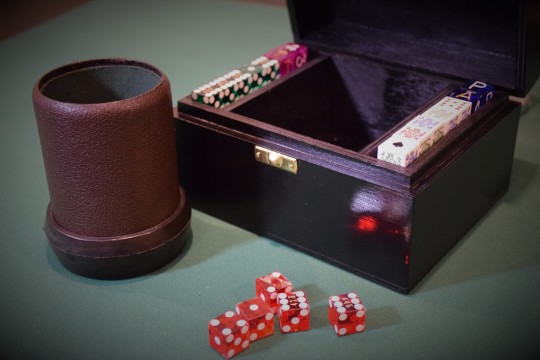
There are a couple of whip cups available and more will be added as I finish restoring them. All whip cups have an exterior made out of leather and the interior is made of a special secret fabric that is used for gaffing the whip cup. There are 2 types of whip cups: leather bottoms and black rubber bottoms. The black rubber bottoms were very popular in the sixties as most dice games were played in bars. The rubber bottom would protect the cup from beer spills, dirty tables and keep the circular shape of the cup as people were banging them on the tables.
I also learned to make crooked dice and work the edger. Each whip cup comes with a set of dice that can be gaffed to make any combination you want. You can play Bar dice (aces are wild), Cee-Lo, poker dice, put ‘n take, etc. You will always win! You can also buy more dice so you have multiple games and gambling demos.
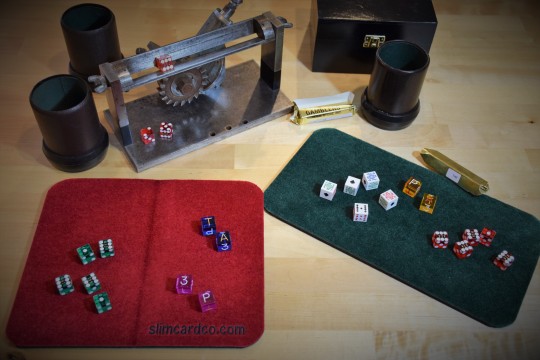
What is interesting about a whip cup is that both the cup and the dice have to be gaffed with some devious trickery but neither work without the other. There is also a certain “move” you need to do in order for the whip cup to work. It will not work for the other players or spectators. All of this is explained in a video that is included with the whip cup and dice. In this 60 minute video, you will be taught how to use the whip cup and how to build a proper gambling demo with dice games. The explanations are narrated by me and Fast Jack. You will also learn where the cups come from and how they were restored as well as some explanation on how to make edged dice. You will also get some exclusive videos of Fast Jack showing some dice switch, decks switches, and his move to negate the cut.
Cheers,
Slim
youtube
0 notes
Text
The Secret Lab
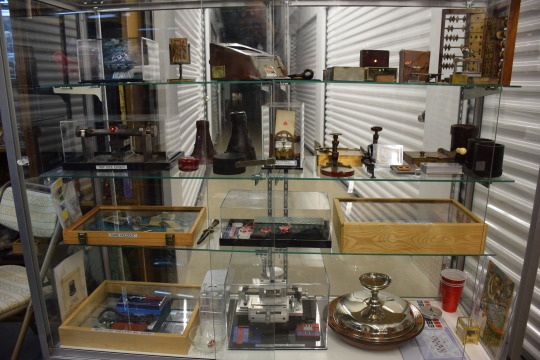
A few weeks ago, I had the privilege of visiting Terry Roses famous secret lab in Minnesota. For a guy like me that makes gaff playing cards and dice, it was like visiting the Shangri La or going to a place where all you’re Holy Grail quests may be found. I am not sure I am translating these expressions well but you should get the idea that a lot of things I saw in Terry’s lab are things I am working on and looking for. Terry was extremely generous of his time and knowledge!
Me, Jeff and Raj arrived in Duluth around 10h30 and we spent over 16 hours with Terry and Alex. Passing security gates and electronic doors, I finally saw with my own eyes what I had heard about for many years by fellow gaffers, the secret lab! Alex had set up everything so we could visit, browse through old books, gambling catalogs, and see a display of many gambling treasures. Terry did the lecture he usually does for casinos and explained how he invented the ultimate “Inspecta Card Scanner” that can detect any high technology marks that are used on playing cards. As he says, it started with a kid’s dream to have real X-ray vision glasses. We then browsed through old gambling books like an original Advantage Play by F.R Ritter, a Discovery of Witchcrafts and some very old and obscure gambling supply houses catalogs. We also talked about his friend Walter Scott, the phantom at the card table.
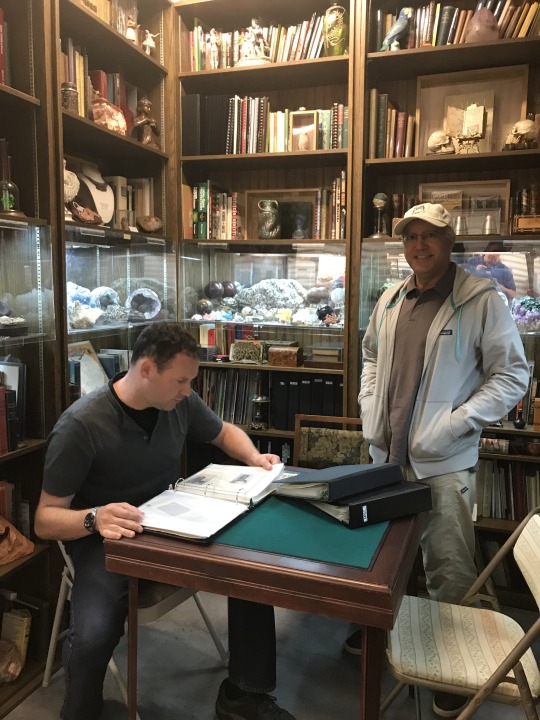
After a little lunch break, Terry demonstrated all kinds of crooked gambling devices, from Faro boxes, to blackjack shoes, then to punch work, negative work, dice work and of course whip cups. It is always a pleasure seeing a master of his craft doing an exhibition.
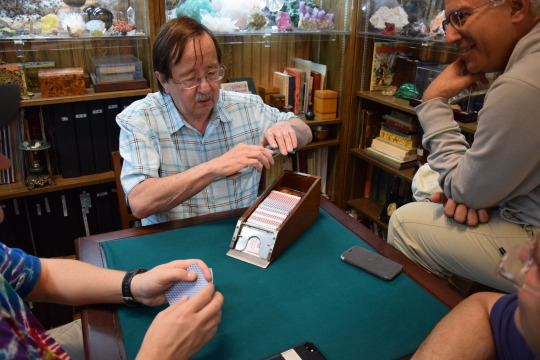

I also had the opportunity to make some Ns with the first machine Todd Lassen ever created, Terry’s first jig and use some antique corner rounders. We exchanged some techniques and traded some secrets in the art of card trimming and dice making. I do admit Terry had a lot more secrets to reveal to me than the other way around. It was very humbling talking to him.
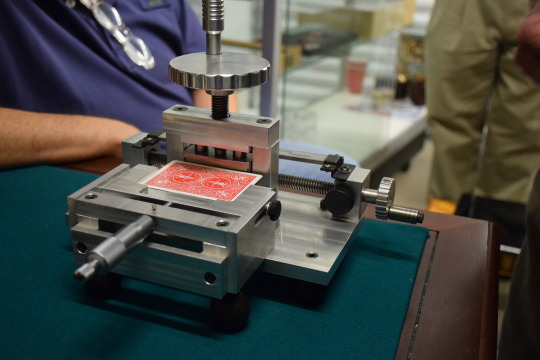
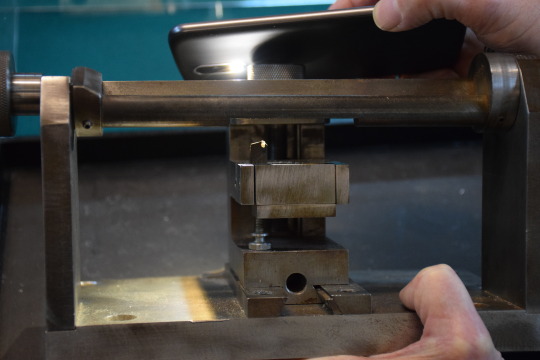
So far, it was a gaffer’s paradise and we hadn’t been in the back lab yet. The high tech cheating inventions were yet to be showed. Terry was always saying: “Boys, let’s say we burn the midnight oil!” And that we did. It was a 16 hours marathon in Terry’s secret lab. We started learning about Terry’s really great inventions around 10h after dinner. High tech glasses to see marks on playing cards impossible to see any other way, solid plastic that you can see through with only a special camera and more. I am pretty sure a cheat would love putting his hands on this technology! I was speechless.
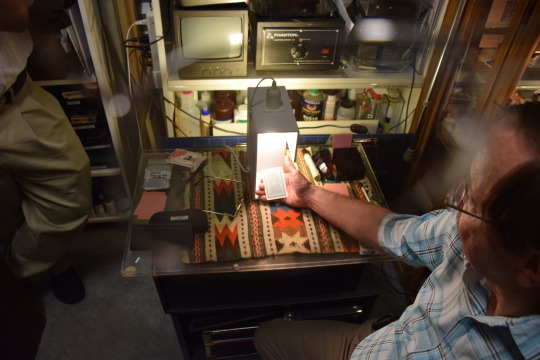
Thanks everyone for making this possible. Again, Terry your limitless generosity is really appreciated! Alex, thank you for showing us some prized pieces of your book collection, your tribute to John Bushey and your demo of the spinning nickel. The spinning nickel trick and hustle will stay for a very long time in the back of my head and I am still working on your technique, bravo! Raj and Jeff, thank you for making this happen, I own you guys, all you guys, big time!
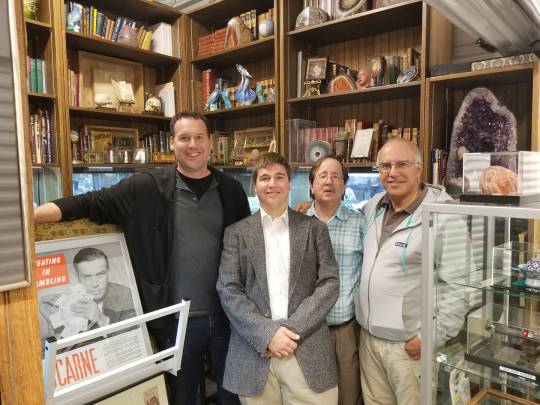
Over the next few days, I’ll be posting some pictures and videos of Terry’s lab. Stay tuned. As for me, I can’t wait to have another visit in the lab…
Cheers,
Slim
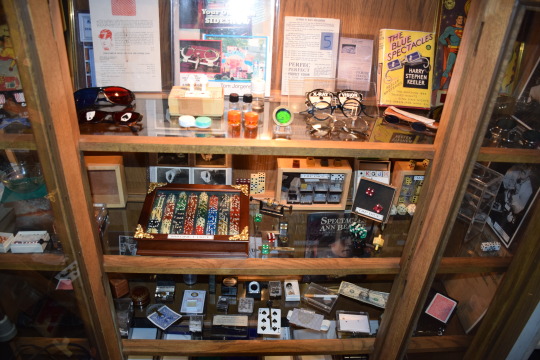
3 notes
·
View notes
Text
Blue seals, Red seals, black seal, Aristocrat stock, Bees and a lot of playing cards!
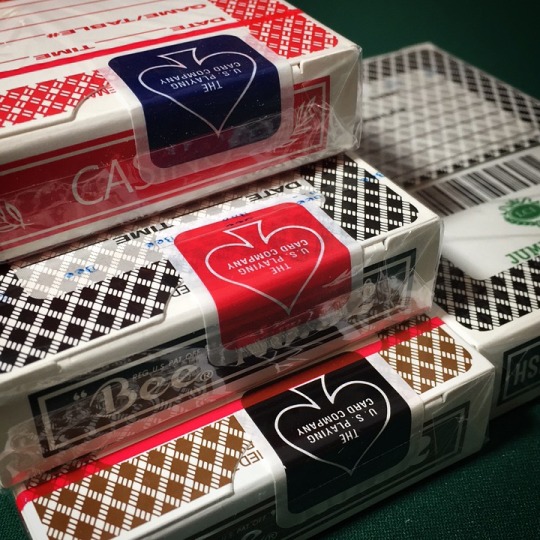
There has been a lot of talk about blue seal decks versus black seals deck and it sometimes can be confusing whether you are a collector, a magician, a cardist or a poker player. In this article, I will do my best to answer some of those questions and provide additional facts concerning playing cards from USPCC. I do not have all the answers and some of the things I write are guidelines and not definite truths. I sometimes even wonder if the people that work at the UPSCC plant still know about how they used to make playing cards in the old Ohio factory. It feels like they have lost some of the techniques and knowledge over the years. There is even a rumor that suggests that they can’t even make the Steamboats (and I love those cards!) like they used to because they were considered their cheap stock and they just threw the recipe away. But let’s carry on!
My information comes from various persons but a lot I have heard from Lee Asher, magician and president of the 52 plus Joker club: http://www.leeasher.com/playing_cards/collectors/clubs/52_plus_joker_playing_card_collectors.html
He also shows how to date a deck of cards here: http://www.leeasher.com/playground/articles/how_to_date_a_deck_of_cards.html
He also visited the USPCC plant (old and new). As far as I am concerned, he is one of the most knowledgeable people about playing cards and a hell of a fine magician. He also designed his own playing cards. There is also Chris Severson, another fine magician, who wrote a VERY good article on the subject. Chris does not take anything for granted and always does extensive research on subjects he likes. He even went to measure with a precise caliper the thickness of different stocks of cards by brand, year etc. You can fine is article here:
http://www.whoshuffleslikethat.com/almost-everything-you-need-to-know-about-blue-seals/
So here are couple of random information and answers to your questions.
First, here is the way to know if the playing cards come from Ohio (before 2009) or Kentucky (2009 and after). The USPCC plant was moved in 2009 and the decks from that year are mostly terrible (Especially Bicycle). They have become better after 2012.
Black seal: Kentucky, year 2009 and after
Blue seal: Ohio, before 2009.
There is no way to get around it. A black seal Bicycle deck (regular) comes from Kentucky. Even if the box says Ohio, it’s from Kentucky when wearing a black seal. That is because the leftover boxes were moved to the new factory. There may be some exceptions to this called a transformer deck where the box and cards were made to the old factory but were moved to Kentucky before being sealed and shipped.
Now here is what you can say about casino playing cards:
Black seal: Kentucky, year 2009 and after
Blue seal: Ohio, before 2009.
Red seal: Ohio, before 2009. (Better quality)
The red seal has the same meaning then the blue seal regarding the location of the factory (Ohio) and years. Some people will claim that the red seal are for casino card only. That may be true in most case as I did not find a lot of red seal decks that are not for casinos but I have a lot of casino playing cards with blue seals. My guess is the red seal may, at one point, signify higher quality and were reserved for special customers like casinos. They were offered as an option to use for custom/casino decks instead of the common blue. What is neat about having a sealed and unopened casino deck is that there is always an extra card with a barcode for the casinos (maybe for the automatic shufflers) that writes the exact date (month, day, year) the deck was produced. So you always know at what factory this deck was produced. Any other colors was when they decided to start doing custom seals (white.)
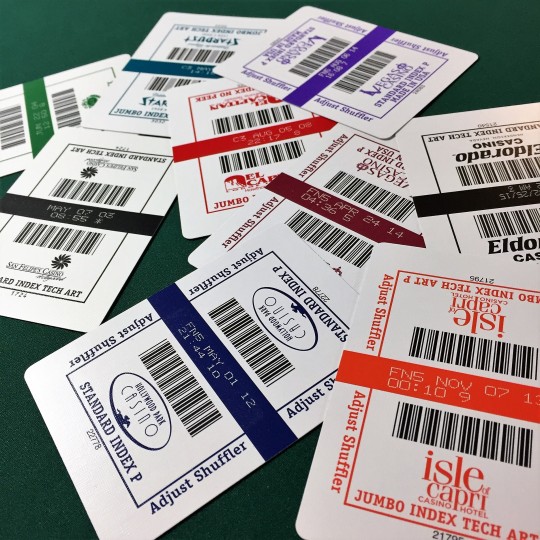
Casino playing cards stock and finish
As for the stock for casino playing cards, USPCC have 2 types of finish: Aristocrat (casino finish) and Bee (cambric finish). First, let’s get a fact straight, the playing cards are printed on the same paper (or stock). Air cushion, cambric, smooth, ivory, casino, magic and all other kind of finish are printed on exactly the same cards (same paper, same thickness). The difference lies in the way they apply the varnish at the end of the process. If they want air cushion finish, they will roll a kind of big press with needles that will create the little dimples that make the finish as we know it on classic Bike decks. It is mostly how you finish the process that determines the feel of playing cards. Bicycles feel thinner because the dimples in the finish are deeper than in the cambric finish for Bee playing cards. Ivory and smooth means there is no dimples applied to the finish. These cards will feel thicker and less flexible. (A great way to make a rough and smooth deck for Blackjack but I digress!)
Having said all of this, let’s compare both stocks of casino playing cards. The Aristocrat cards (casino finish) feel thinner and more flexible than the Bee cards (cambric finish). Bee cards feel thicker and break-in harder. But the Bee playing card will last longer. They are also more expensive to produce as casinos will have to pay more per deck. The aristocrats are the cheaper option for casinos. These observations are true for cards coming from Ohio and Kentucky. But we also see some differences between the factories.
Aristocrat blue seals decks (from Ohio) will Faro very well. They wear out fast and wave but the Faro you can do when they are coming out of a box is awesome! (Try a Stardust casino deck if you can, wow!!!) Bee blue seal decks (from Ohio) are tough and durable like crazy. You have to put the work in at first so they won’t spring on you. They feel good and are perfect for putting trim works in them (belly strippers and N work). The decks will always be good and precise when using them. Put them in a card press to get them feeling like brand new. I really like these old casino decks from Ohio! Although lately, I have some fine casino playing cards that were printed in 2015.
Card face design and index
A lot of casino like Jumbo index. It is a little harder to find regular index in casino playing cards, so if you have a back design you like you might want to stock up on them. There are also different types of index to help the dealers like the no peek index, etc. For example, Blackjack dealers in some casinos will have a mirror built in the table allowing them to see if they have 21 without really peeking at the cards. These casinos will use No peek index cards. The Aces have a big black mark on the top right, while all cards worth ten have a mark on the top left and all the remaining cards have no marks reaching the top of the card. If the dealer spots a mark on the top of each card face in opposite corners, the hand is a blackjack. So basically, all these modifications on the face of the cards are to help the dealers in casinos.
Here is a list of the different index found in casino playing cards:
1. Standard index: This is the standard index you will also find on classic Bicycle playing cards.
2. Jumbo index: This is the standard index you sometime find on Bicycle and Bee playing cards.
3. Standard index P: These are standard index but sometime the casino will ask for values below ten for the index to be slightly lower than a regular index. This will help a Blackjack dealer counting the value and see quickly if he has a Blackjack. Not as efficient as the no peek indication.
4. Standard index tech art: Almost exactly like the one above. The main difference is all the aces always have for pips (index on all 4 corners).
5. Standard index tech art P: As above…
6. Jumbo index P: Almost the same as a classic jumbo index.
7. Jumbo index no peek: The Aces have a big black mark on the top right, while all cards worth ten have a mark on the top left and all the remaining cards have no marks reaching the top of the card.
8. Jumbo index no peek P: Almost the same as above.
9. Jumbo index tech art P: All the aces always have for pips (index on all 4 corners). The value below the 10s have their index a little lower on the playing card.
Here is a little guideline from USPCC for their Bee brand casino cards: http://www.usplayingcard.com/wp-content/uploads/2016/02/14441_USPC_ChooseADesign_SalesSheet_RUN.pdf
Finally, I noticed there is not many factory sealed and uncancelled casino playing cards sold in the USA. Of course, we are talking about cards from casinos that closed or had a big administration change. Casinos still operational will never allow their playing cards to be sold. But why so few of the closed casinos sold in the States? My guess would be that USPCC have a deal that they don’t sell them in the USA but they can sell them to other countries. I know I used to be able to find them easily. Maybe I am sitting on a gold mine that will soon be depleted. Who know?
Cheers,
Slim
p.s. I also added another post below in the blog with a list of all the blue seal and red seal decks from Ohio along with a list of the regular index decks if you want to know what we sell on our website.
2 notes
·
View notes
Text
OHIO "BLUE&RED SEAL" playing cards
I have made a list of sealed and uncancelled casino playing cards that come from the USPCC Ohio factory and have a blue or red seal. The decks are all before the factory moved in 2009. All these decks can be found on our website at https://www.slimcardco.com/casino-bee
BLUE SEAL
Aristocrat Colorado Grande Casino Red (2009)
Aristocrat V Casino Blue(2002)
Aristocrat Golden Phoenix Orange(2005)
Aristocrat Grand Casino Gulfport Blue(2007)
Aristocrat Grand Casino Biloxi Blue(2005)
Aristocrat The Isle Casino Red (2008)
Aristocrat Central Palace Casino Blue (1991-1992)
Bee Carson Station Casino Black (2008)
Bee BeauRivage Casino Blue (2005)
Bee 77 Ratonoe Casino Blue (2001)
Bee F Casino Blue (2004)
Bee SevenLuck Casino Green (2008)
Bee SevenLuck Casino Red (2008)
RED SEAL
Aristocrat Victories Casino Blue (2006)
Aristocrat Pharaohs Casino Red (2006)
Bee LCI Casino Green (2004)
Bee SliverClub Casino Pink (2008)
Bee St.Croix Casino Blue (2009)
Bee San Felipe's Casino Black (2003)
Bee Lucky Ticket Casino Burgundy (2005)
Bee WestWard-Ho Casino Blue (2005)
Bee El Capitan Casino red (2008)
STANDARD INDEX PLAYING CARDS
This is a list of all the sealed and uncancelled casino playing cards that have standard index. Aristocrat Las Vegas Casino Red
Aristocrat Las Vegas Casino Blue
Aristocrat Las Vegas Casino Purple
Aristocrat Las Vegas Casino Burgundy
Aristocrat Eldorado Casino Black
Aristocrat Eldorado Casino Red
Aristocrat Grand Casino Biloxi Blue
Aristocrat V Casino Blue
Aristocrat Hollywood Park Casino Red
Aristocrat Hollywood Park Casino Blue
Bee Bahamar Casino Burgundy
Bee Bahamar Casino Turquoise Bee GBC Casino Red
Bee Beau Rivage Casino Blue Bee SevenLuck Casino Red
Bee SevenLuck Casino Green
Bee San Felipe's Casino Black
Bee Kangwon Land Casino Gray
2 notes
·
View notes
Text
Hands of the card expert
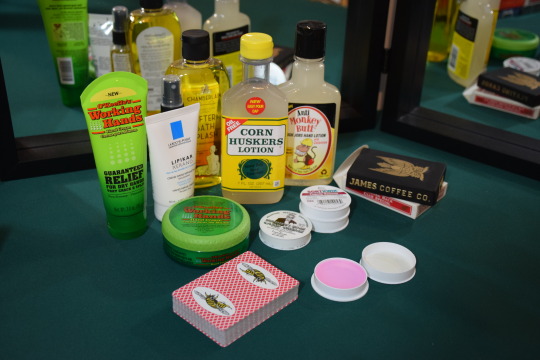
The most important things to a magician and card experts are his hands. Of course, as we get older, we lose some of that dexterity and our hands become dry and less flexible. Now, I don’t have any dexterity issue yet but with our long, cold and harsh Canadian weather, I do have the dry hands problem, especially during winter. I sometimes can’t deal a single second without licking my thumb and I even have a hard time doing some palms. So, I found some solutions talking with other magicians and by looking through some books. I decided to write about some long term solutions and some secrets for specific sleights. After all, it wouldn’t be a good article if it had no secrets!
It’s very important to take care of your hands and you have to do that before they become a problem. For instance, I put hand cream on my hands more than once per day. There, I’ve said it, now you can judge me! But it really helps with some sleights. It also keeps my hands in good condition. You don’t want your hands to look all worn out and dry when doing you are performing. For daily use, I use Lipikar Xerand hand cream repair. This one works for me but I assume any good quality hand cream should do. I know a magician that only uses Neutrogena hand cream and Golden Touch. Recently, I tried O’Keeffe’s Working Hands but I can’t conclude yet (more on that later). I know Jason England uses O’Keeffe’s Working Hands in a tube just before performing with a deck of playing cards.
These tips are not only coming from me, it was a frequent topic of conversation between Dai Vernon, Larry Jennings, Bruce Cervon and other cardmen at the Magic Castle. You have to take care of your hands, especially as you get older! For instance, according to Michael Perovich in his excellent book The Vernon Companion, in his later years, Dai Vernon was always looking for the perfect cream to keep his hands in healthy working condition for every sleight of hands he was known for1. People, magicians and friends would come up to him at the Magic Castle and make him try all types of hands lotions. The verdict would often be “No good” and Vernon would walk away to go wash his hands. It was particularly true if it contained lanolin. It was told that even if the hand lotion was good for working with cards, if it contained this dreaded ingredient, Vernon would immediately cast it aside.
Here comes the more secret part of the story… People that hang out with me know that I am fascinated by second dealing and that it is my favorite sleight. As I mentioned earlier, I don’t want to lick my finger just before second dealing a card, it’s an obvious tell to magicians (and fast company) and it lacks finesse. Of course, there are solutions. For example, if you can have a cold glass of water next to you, you just move it and the vapor that forms on the outside of the glass will give you enough moisture to make a perfect second deal. Martin Nash had an excellent idea to aid his second deal. He would put on Sortkwik, the product used for counting dollar bills. This is awesome!! You will never miss a second when using this! You have to be careful not to put too much and dirty your playing cards but it’s not greasy and does not stain the cards. This is now my go to product if I have problems with dealing deuces. Our Canadian winter can be very harsh and will sometime cause my hands to be a little too dry for an effective second deal. The problem is solved with just a little bit of sortkwik on my right thumb. It also works for other sleights like false shuffle and palming. I was told Martin Nash would put it behind his ear and just scratch it a little before doing a false deal. This would put the amount needed on his thumb. There is also Skinner’s edge card crème I use for the same reasons. It looks and is used for the same reasons but it’s superior then Sortkwik for what we magicians use it for. In my opinion, it’s the best product for sleight of hands. As I mentioned earlier, O’Keeffe’s Working Hands will give you similar result but is less effective than Sortkwik and Skinner’s edge card crème, at least as far as I am concerned. So, take care of your hands and maybe you will live a long full life like Dai! (Not clinically proven!)
Cheers,
Slim
p.s. I decided to put other lotions without mentioning them as a little secret. You can probably figure it out…Any dicemen reading this?
Footnotes 1The Vernon companion by Michael A. Perovich, p.227-228
4 notes
·
View notes
Quote
I told old man Webster, I don’t care about other card trimmers, I want the one you’re using.
Richard Canfield
2 notes
·
View notes
Text
Top 5 movies for cardsharps and magicians
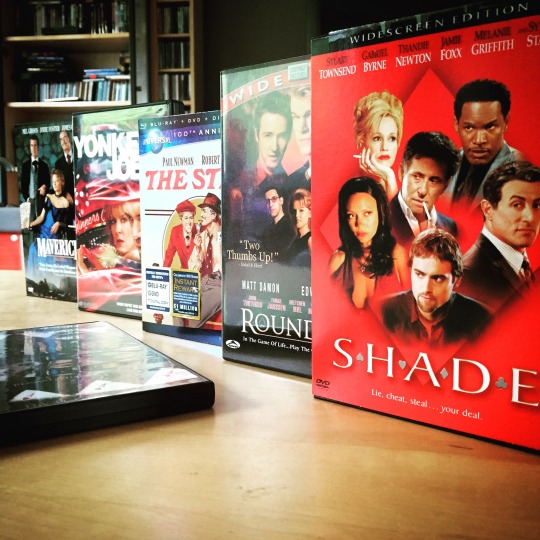
Rainy week-end? This article might give you ideas on what to watch instead of looking at the rain pour. These are my top 5 favorite movies where you witness some cardsharps sleight-of-hand, poker stories and a little cheating and magic.
1)Shade: This movie with Sylvester Stallone and Jamie Foxx went under the radar in 2003 but it has a good story. Now, if you are a magician that has a passion for cards and magic history, this movie is for you! Damian Nieman, a magician and Dai Vernon aficionado, wrote and directed this movie about underground poker games where small-time hustlers want to make a good scam against the Dean, a master cardsharp that as ruled the card games for many years. What makes this movie #1 is the little things you find in the movie. First of all, the introduction consists of card moves by R. Paul Wilson and Jason England, great card experts that need no introduction (you can see more card moves in the bonus section). Every character have a name that comes from the magic world. The main characters are named Vernon and Charlie Miller, The Dean is Stevens (the gentlemen that introduced his cull method to Vernon), the detective is named Scarne, etc. You will also see allusions to the expert at the card table book, to the 808 (bicycle cards number) and more. My favorite line is the reference to the Dai Vernon’s quest for the middle deal when Miller’s says he’s more of a dice man.1 If you like Nieman’s directive style, he also did the Fast Company DVD set that are excellent. But it’s more of tutorial for magic and card moves than a movie.
2) Rounders: This movie with Matt Damon and Edward Norton is the classic movie for all serious poker players! A lot of professional poker players gave poker a try after watching this movie. For many years, you would hear a quote from this movie if you were to sit in a poker room for more than an hour. Mike McDermott, a gifted poker player, retired from poker after losing his 30000$ bankroll in one game. He starts playing again to help a childhood friend out of prison who is also a card mechanic. This story is based on the poker underground scene in New York City. The Chesterfield Club is a replica of the Mayfair Club that used to be the mecca of poker in NYC. You can’t help to root for Mike as he goes from game to game. There is a lot of movies about poker, but only one that captures the essence and energy of poker. That movie is Rounders.
3) The Sting: This movie won the Oscar for best picture and the actors Paul Newman and Robert Redford are two of the reasons this success. The story revolves around 2 conmen who plans revenge on a mob boss with a perfect con. The sting is the moment the money is taken and if the con is successful, the mark (victim) won’t even realise he has been taken (cheated) until it’s too late to do something about it. The play (build-up of the con) is intriguing and you get to see some poker, horse betting, etc. As a bonus, all the sleight of hands for Newman’s character are doubled by the famous card expert John Scarne.
4) Yonkers Joe: This movie is about a cardsharp and dice-hustler that is trying to make a big hit and taking care of his 21 year old son who has Down’s syndrome. He and his son will try to redeem themselves while also trying to make a big hit in a casino crap game, the most dangerous place to be caught cheating. While I did not go crazy on the plot, I really like how Joe’s surroundings in the movie were made realistic. He drops in a “cooler” in a poker game quite nicely and do very realistic dice switches. You also get to visit the office of a pro gaffer ( the guy that makes the gaff cards, gaff dices, tops, etc.), which is my favorite part of the movie! But this movie is also about a lot more. The movie is directed by Robert Celestino and Yonkers Joe is probably his father. So he made a point of getting every detail as accurate as possible. For instance, he asked “Fast” Jack Farrell to be a technical advisor and you have an interview with him talking about hustles in the bonus section.2 Robert Celestino is also a great card mechanic and you can see what he does with a deck of cards also in the bonus section. Only for these last 2 reasons, you have to see this movie if you have an interest for dice and cards sleights.
5) Maverick: This movie is classic western with Mel Gibson is simply fun to watch. You get a nice story with cowboys playing poker and lots of gun slinging. Not much card expert material, but an overall funny story.
Cheers,
Slim
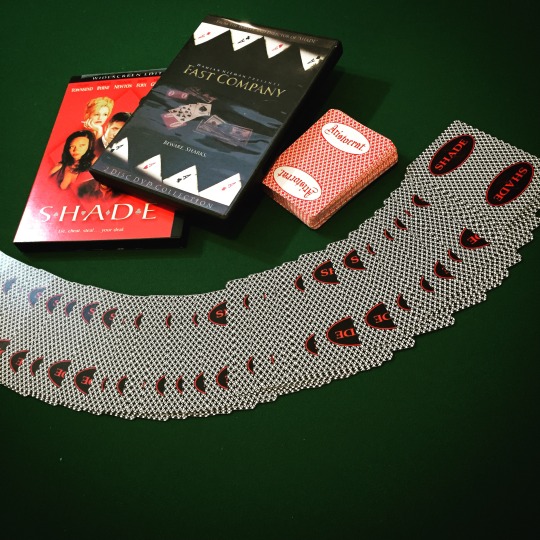
Footnotes
1: You can read more on this anecdote in the book The magician and the cardsharp by Karl Johnson, p.175
2: You can read more of Fast Jack’s story in the great book Fast Jack: The last hustler by John Farell. You will also learn some of Bobby Celestino exploits…
2 notes
·
View notes
Text
Dai Vernon’s elusive N-strippers
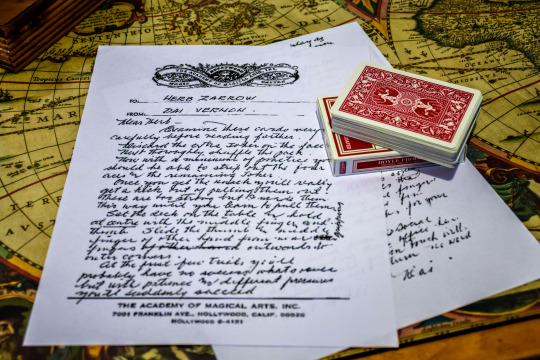
This article is about my quest to find out about the elusive N also called N-stripper, In-stripper, Notches, Negative stripper, concaves and more. There is still a lot of taboo when discussing these kinds of strippers. Many feel it’s one of the last secrets we should not be showing. Others say it’s too good and complicated for it to be known in magic’s mainstream community and that it’s still has its place in the underground world of the cardsharps. That being said, I don’t think it is a guarded secret anymore like it was in the nineties. There are also some major magic suppliers and companies that will be starting to sell these types of cards in the close future. You won’t learn about them and how to use them in this article, but you will have a good idea of what they are and why Dai Vernon liked them so much.
As I have wrote before, I have a deep passion for card trimming, be it in magic or gambling. In the early 2000s, I began to learn about cutting belly strippers, end strippers and many other kind of devious gaffs used by magicians and cardsharps. I started hearing about the so-called highly deceptive Ns, the greatest weapon of card cheats (I am not saying they are, but these were the words I was hearing). Since it concerned card trimming, obviously, I just had to learn about them and how to make them! That and the fact it’s one of my guilty pleasure to seek for secrets.
Back then, N-strippers were still a guarded secret that few magicians even knew existed. Googling it would give you no results besides some pulpous girls in a bikini (or even less). So, the rare people that used or made them were reluctant to share it with me. I knocked on a lot of closed doors that just wouldn’t open for me. Without giving up, I was out of resources but kept an eye out if I happened to spot something. By sheer luck, I stumbled on an internet auction that was selling “negative strippers handmade by Dai Vernon”. The deck of cards came along with a letter correspondence between Dai Vernon and Herb Zarrow. I had some success with my researches but to have a negative stripper made by Vernon, I just wanted to have it. I made an initial bid of 150$ but lost the race… It was sold for 2400$, a little too much for my budget at the time (I think it was auctioned again afterwards). But this gave me the chance to read what Dai had to say to Herb about negative strippers.
This letter gave me the opportunity to learn more on how to use them; I guess Dai Vernon is a pretty good “professor”. It also gave me access to a little piece of history. Vernon was known to spend a lot of time with gamblers and cardsharps in the hopes of gaining secrets that he would then use for magic. He would literally drop everything if he could meet a shadowy character that could do an exotic move with a deck of cards. I learned that the person who showed the negative strippers to him was a hustler making good money in Vegas with them.
The thing I found very interesting was that he claimed that “The beauty of this work is that no one unless they have developed the “feel” can discover that the cards strip.” He would even use them sparingly to fool magicians at the Magic castle and in the back room of Joe Berg’s magic shop and leave them dumbfounded. Now that was a new goal for me! I wanted to be able to make strippers that would compare to Vernon’s.
Eventually, with the help of a few acquaintances, I learned to make very deceptive trimmers of different types (Negative strippers and more). An underground magician from Toronto, a retired hustler from Las Vegas, etc. are some of the people that have helped me and that I would like to thank.
But I think one of the starting point was this letter. You can read an edited version below this article.
Cheers,
Slim
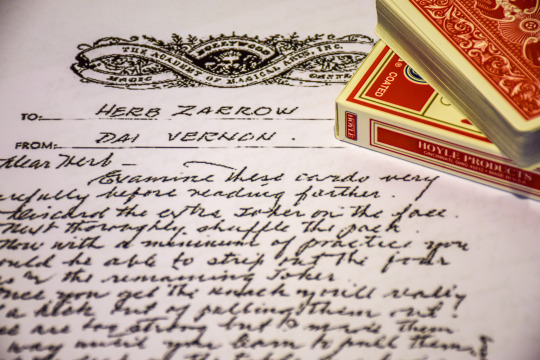
To : Herb Zarrow
From : Dai Vernon
Dear Herb,
Examine these cards very carefully before reading any further.
Discard the extra joker on the face. Next thoroughly shuffle the pack. Now with a minimum of practise, you should be able to strip out the four aces and the remaining joker.
Once you get the knack you’ll really get a kick out of pulling them out! These are too strong but I made them this way until you learn to pull them.
Set the deck on the table and hold at centre with the middle finger and thumb. Slide the thumb and middle finger of other hand from near gripping fingers outwards to outer corners.
At the first few trials, you’ll probably have no success whatsoever but with patience and different pressure you’ll suddenly succeed.
This work is put on during play as the desired cards come into your possession. The enclosed were not made this way needless to say.
The ones I am inclosing are far too strong for the chap who specializes in this work. I have been trying for months to pull some that he used in a game and find it next to impossible. This Italian chap recently won 70 000$ in Vegas using this work. He bought a 150 000 $ home in Palm Springs and is one of the best bottom dealers I’ve ever seen.
The beauty of this work is that no one unless they have developed the “feel” can discover that the cards strip.
Poor Berg is going daffy trying to figure out the method.
Have only done it a few times for him and he made me wash my hands the last time. He thinks there is some chemical on the edges of the aces that clings to something put on the fingers.
Well Herb, hope you have fun with these cards and thanks for your card.
Have not heard from the social security since visiting their office here. Asked me if they could get in touch with you regarding the 1964 return. No word as yet, pro or con.
Best to all,
Dai
THE ACADEMY OF MAGICAL ARTS. INC.
70001 FRANKLIN AVE. HOLLYWOOD. CALIF. 20026
HOLLYWOOD G-4181
Footnotes:
* Joe Berg (1903-1984): He was magic dealer and his magic shop was on the second floor off Hollywood Boulevard. It was the perfect hangout for magicians in the know. Source: The Vernon Companion by Michael A. Perovich
**Herb Zarrow (1925-2008): He was a close friend of Dai Vernon from their New Jersey days. He invented the Zarrow shuffle, one of the only sleights that made it form the magicians to the gambling cheats. Usually, card moves would come from the hustlers to magicians like the Ns. Sources: The Vernon Companion by Michael A. Perovich and Second to none by Simon Lovell
2 notes
·
View notes
Text
Dai Vernon and gaffs
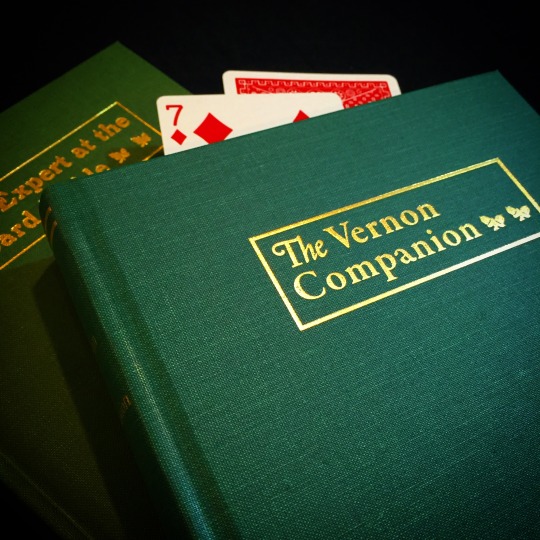
Dai Vernon always said that “if a fellow wants to make any kind of a reputation in cards and be known as a magician […], he must not use trick cards.” He would advise fellow magicians to stay away from such cards.1
But what Vernon said and what Vernon did are two different things. I personally think he sometime used gaff cards if he thought they were necessary for a magic effect. For instance, the first time he was in New York and set foot in Power’s magic shop, he wanted to see some good magic and probably make a good impression and open some doors for himself.2 When Paul Carlton, who was behind the shops counter, started showing tricks with a wedge stripper, he immediately said he knew the trick and asked for tricks with a regular deck. He even offered 20$ (a lot of money back in 1915) if he had a trick that could fool him. When Carlton became frustrated and asked Vernon if he could do a trick with these regular cards, Vernon picked the deck of cards for a second, put it back on the counter and asked if there was any place he could wash his hands. Unknown to Carlton, he had just palmed a card from his deck in order to create a short card (actually a scallop short3)! He then replaced the gaff card when picking up the deck and did tricks that blew Paul Carlton’s mind. So much in fact, that he called the shop owner, Clyde Powers, to have a look at this awesome young magician. This then opened doors for the young Vernon and he was invited in the back room where only top notch professional magicians like Kellar, Ching Ling Foo and Houdini were allowed. So it’s a gaff card used by Vernon that opened the door to the secret world of New York finest magicians.
Dai Vernon was also known to spend a lot of time with gamblers and cardsharps in the hopes of gaining secrets that he would then use for magic.4 He would literally drop everything if he could meet a shadowy character that could do an exotic move with a deck of cards. One of the best secrets he found regarding gaffs was the infamous Ns or negative strippers from a gambler that used them in Las Vegas. I will write more about this story as it is the subject of my next article. But he would use them sparingly to fool magicians at the Magic castle and in the back room of Joe Berg’s magic shop and leave them dumbfounded. Vernon once explained to Herb Zarrow that “the beauty of this work is that no one unless they have developed the “feel” can discover that the cards strip.”
Like most magicians, I started doing magic using trick decks and then became a purist that would never be seen with anything but a regular deck of cards in my hands. But you get to point that what is important is the effect and not the method. Now, if a gaff will enhance the effect, be it in a context of magic or gambling, I have no shame in using it. Of course, the effect has to be worth it and the gaff has to be of great quality and very deceptive. The gaff must not ruin the trick but make it better. For example, nothing beats using belly strippers or Ns of great quality in a gambling demo. You start with tricks and sleights that do not require gaff cards and once you have established yourself, then you can take out the gaff deck. That should be said about every branch of magic. You start with effects that do not require gaffs or setups and then you use a gaff. Then, you can bring in the gaffs with a deck switch, have it from the start but you use it as a regular deck of cards, etc. Of course, I think the gaff deck should be good enough that it can stand a normal examination.
So, I guess if gaffs were good enough for Dai Vernon, they are good enough for me. Try using some, my guess is you won’t be disappointed. Just don’t overuse them.
Cheers,
Slim
Footnotes
1: You can read more on Dai Vernon’s thoughts on gaffs and more in the book The Vernon Chronicles 4: He fooled Houdini by Bruce Cervon and Keith Burns, p.98
2: You can read more on Dai Vernon’s story in the book Dai Vernon: A biography by David Ben, p.45-46
3: The scallop short is explained in the book The Vernon Chronicles: The lost inner secrets by Stephen Minch, p.8
4: You can find a list of many gamblers met by Vernon in the book The Vernon companion by Michael A. Perovich, p.324-325
1 note
·
View note
Text
QUOTES!
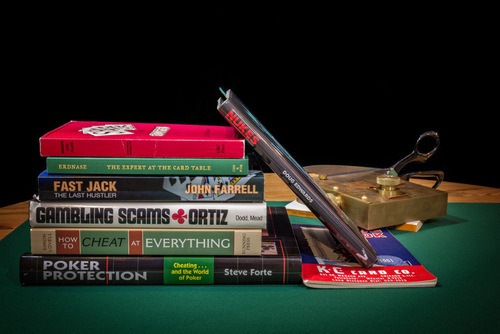
I love quotes! Every time I am reading a book and stop to ponder on a sentence, I usually end up writing it down in small notebook. For years, I used to do it for poker and ended up with 5 pages of quotes that I would write at the end of emails and such, which was always a pain the ass for my friends.
For gambling sleights and magic, the pleasure of compiling is even greater. Every book I ever read on the subject has at least one quote that I kept for future reference. I like to think they will be useful for the book I am writing or… for a website!
So I gathered every quote I had in that little notebook that concerned directly gaff cards, gambling supply house and cheating devices and put them throughout the SLIM CARD CO site. You will read parts of the lives of the greats like Dai Vernon, John Scarne or the mysterious Erdnase and some information from experts like Steve Forte and Darwin Ortiz. The quotes are all scattered across the site. But if you want to read them all at once, they’re right here for your reading pleasure.
Cheers,
Slim slimcardco.com
Quotes:
"I told old man Webster, I don’t care about other card trimmers, I want the one you’re using." - Richard Canfield
“The gambling supply house catalog is distinctly not the safest place to learn about cheating devices, beware of catalog men.” – John Scarne, Scarne on dice
“Forty years of constant “Old Reliable” service has established our reputation for the best product at the lowest possible price. The artists, mechanics, and craftsmen we employ are all capable people with many years of experience, who are always ready to solve your particular problem. For guaranteed satisfaction, learn to rely on the world famous K.C. Card Co.” – K.C. Card Co
“Prepared cards known as “strippers” are much used by certain players. The trimming is done with machines made for the purpose, and the cutting leaves the edges and corners as smooth as glass.” – S.W. Erdnase, the expert at the card table
“The name of ‘strippers’ is derived from the operation which these cards are principally intended to facilitate, and which consists of drawing off from the pack, or ‘stripping’, certain cards which are required for use in putting up hands.” - John Nevil Maskelyne, Sharps and Flats
“Vernon remembered that the KC Card Co. was at Twelfth and McGee, ran by an Old Man Lee, and when I checked the old city directory in Kansas City, sure enough, it was at Twelfth and McGee. Vernon’s memory seems phenomenal.” - Karl Johnson, The magician and the cardsharp
“I’d like to buy a deck of belly strippers, I said. The ones you advertised in this month’s National Police Gazette under the name Lame Novelty Company.” – John Scarne, The odds against me
“Night and day a picture of the showcase of the Lame Novelty Company and its gambling content would seem to appear before my eyes. Then I realized that I could not rest content and continue practising to become a magician until I knew what those gambling gimmicks in that showcase click.” – John Scarne, The Odds Against Me
“When I arrived home, I opened Ame’s package that he gave me as a thank you for working at the Lame Novelty Company and found it contained a number of catalogues describing crooked gambling equipment, several books exposing various cheating methods involving cards, dice, and carnival games, and several books on magic, but the one that impressed me most at the time was Expert at the card table.” – John Scarne, The Odds Against Me
“Within one hour of relaxing my opponent I would switch in a deck of what we call belly strippers – and that was only one part of my huge arsenal.” - John Farrell, Fast Jack The Last Hustler
“I always had plenty of cards in the trunk of my car – all brands, colors, and belly strippers, wrapped in plastic bags so they didn’t warp or discolor. There was also about 5000$ worth of dice.” - John Farrell, Fast Jack The Last Hustler
“On one summer day in 1974, I took the elevator to the 16th floor, walked down the hall and opened a glass door with its familiar gold lettering, Edward’s Dice Company. Inside, a glass showcase displayed all types of crooked gambling equipment.” - John Farrell, Fast Jack The Last Hustler
“One of the most sophisticated stripper decks I have encountered allowed the cheater to pull aces or kings, at his discretion. Minor variation in the contours, different finger positions and pressures, and months of practice made for a very impressive control. The dual combination helps change the makeup of winning hands.” - Steve Forte, Poker Protection
“This country has a long history of firms specializing exclusively in supplying gambling cheats with the tools of their trade. Every gambler who headed west to the latest gold rush town to fleece the prospectors carried a Will & Fick catalog in his back pocket, secure in the knowledge that he could always wire to have marked cards or any other gaff shipped to the nearest express office.” - Darwin Ortiz, Gambling Scams
“Belly strippers! The use of this device is one of the most highly prized – and highly priced – secrets of fast-money winners.” – John Scarne, Scarne On Cards
Many magicians who acquire this book will first search the pages to find the secret of the bathroom strippers, as it has become somewhat of a legend. – Dai Vernon, Inner Card Trilogy
“I was always on the lookout for crooked card moves so I asked him to introduce me to some of the other fellows who were “in”. Anytime I heard there was gambling going on I used to try and see if I could learn anything that could be applied to magic.” - Dai Vernon, He fooled Houdini, the Vernon Chronicles volume 4
"Belly Strippers: The benefit of these cards can be estimated only in oneway, and that is: How much money has your opponent got?" - E.M. Grandin gambling supply catalogue
“I’m 76 years old and I want to leave a gambling legacy. I don’t want my hustling techniques to die with me.” - Slim, An interview with John Farrell
1 note
·
View note
Text
GAMBLING DEMOS
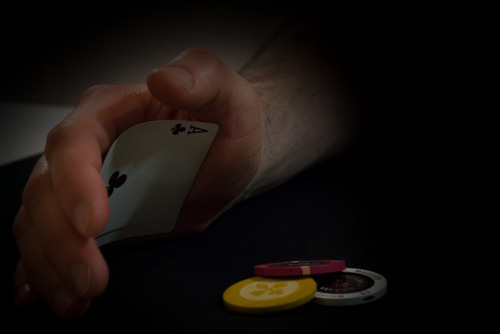
As a kid, I was always fascinated by magic and was thrilled to see a David Copperfield special. But I never got into magic. It just wasn’t that special to me. It was only after my twenties that I started at it. By then, I was a poker player and really into the game. It’s funny because it’s a poker player that showed me a card trick, with a trick deck (brainwave deck) that blew my mind. I immediately wanted to know how to do it AND be able to do it for other people!
Just like that, I started seriously studying magic and learning sleight of hands that enabled me to use regular deck of cards. Like every magician, I had a phase were I was a purist and did not want to even touch a trick deck (I am over that now!). But even though I enjoy good magic, it’s the gambling demos that fascinate me the most. After learning my first sleight of hand, I was always thinking about how it could be used in a poker game. Naturally, I constructed gambling demos and they were always my favorite part to do for a paying audience. I usually do my gambling demos at the end of a gig to guys who enjoy a game of poker. So we sit around a card table and I start doing a little stacking, a ace location where I cut to one ace, find another ace when they say stop using a second deal, etc. A lot of Jason England’s tricks go well for these types of presentation.
Now, imagine the power of adding gaffed cards to sleight of hands in a gambling demo. You give an unopened deck of cards from a casino and you ask the spectator to open it, shuffle the cards and even to wash them (mix the cards all over the table). But it is a deck of belly strippers you have resealed. In only one or two quick riffle shuffles, you have found your ace and can do whatever you want with them. You can start your favorite ace location routine, do a stacking routine or cut to the aces like John Scarne would do! The possibilities are endless! In a gambling demo, if you give the impression of a card expert and use sleight of hand, you can pass off using a gaff deck. You already have installed your credibility. So the trick or demo you do now becomes a miracle by adding a little gaff. And, usually, they will credit your expertise you showed earlier instead of suspecting the cards. Try it, you will see what I mean.
Cheers,
Slim slimcardco.com
3 notes
·
View notes
Text
MY VERY OWN SITE!
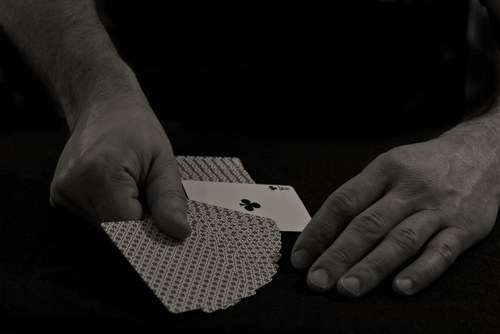
For years I always wanted a place to see old gambling cheating devices, gaffs, playing cards, old gambling supply house catalogs and more. I wanted to learn about them and know where I could find them. Also, it is always a pleasure to find new discoveries and, let’s be honest, to do magic for someone.
Well, I was always thinking that I should do a site that would combine my passions and discoveries, so instead of talking about it, I decided to do something about it! So with the help of friends, we now have our own virtual museum of gambling gaffs and magic. Of course, it is a work in progress and we will keep adding things along our discoveries. We also have a store that sells gaffed cards to magicians and performers that are of great quality unlike the regular strippers you find in jokes and novelties shop. You can also learn how to use those tricked cards with videos that will show you how they worked and how to enhance your magic and gambling demos.
This blog will be a place where I can share some thoughts on magic and gambling gaffs. I consider chasing after some secret method as much a thrill as finding it! So if it’s of any interest, you will be able to follow me along some discoveries and some future projects.
Cheers,
Slim
Slimcardco.com
3 notes
·
View notes